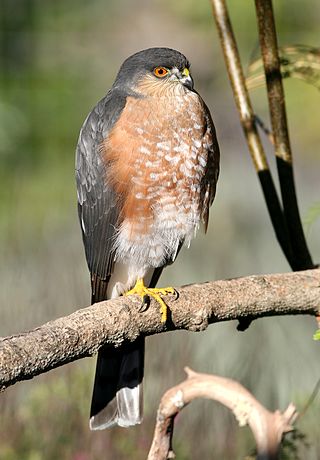
Celestus is a genus of diploglossid lizards mostly endemic to Jamaica and containing about 11 species, though three of these may be extinct. They are commonly known as galliwasps although the origin of this name is unclear. Formerly, this genus had more than 31 species, but a 2021 phylogenetic study found this classification to be paraphyletic and split those species into their own genera. A more recent study found that several ecomorphs exist on Jamaica including a swamp ecomorph, a tree ecomorph, and a ground ecomorph.

Ophiodes is a genus of South American legless lizards in the family Diploglossidae.

The sharp-shinned hawk or northern sharp-shinned hawk, commonly known as a sharpie, is a small hawk, with males being the smallest hawks in the United States and Canada, but with the species averaging larger than some Neotropical species, such as the tiny hawk. The taxonomy is far from resolved, with some authorities considering the southern taxa to represent three separate species: white-breasted hawk, plain-breasted hawk, and rufous-thighed hawk. The American Ornithological Society and some other checklists keeps all four variations conspecific.

The eastern chipmunk is a chipmunk species found in eastern North America. It is the only living member of the genus Tamias.

Lycodon striatus, commonly known as the northern wolf snake or the barred wolf snake, is a species of nonvenomous colubrid snake from southern Asia.
Sajnekhali Wildlife Sanctuary is a 362 km2 area in the northern part of the Sundarbans delta in South 24 Parganas district, West Bengal, India. It is located at the confluence of the Matla and Gumdi rivers. The area is mainly mangrove scrub, forest and swamp. It was set up as a sanctuary in 1976. It is home to a rich population of different species of wildlife, such as water fowl, heron, pelican, spotted deer, rhesus macaques, wild boar, tigers, water monitor lizards, fishing cats, otters, Olive ridley turtle, crocodiles, Batagur terrapins, and migratory birds. The ideal place for nature lovers to observe wild animals from a height is the Sajnekhali Watchtower.

The western three-toed skink is a species of lizard with tiny legs in the family Scincidae. It is found in the Iberian Peninsula, southern France and parts of northwestern Italy. Its natural habitats are temperate forests, temperate shrubland, Mediterranean-type shrubby vegetation, temperate grassland, sandy shores, arable land, pastureland, and rural gardens. It was first described 1829 by the French naturalist Georges Cuvier. The generic name comes from the Greek "chalcides" meaning 'copper' and the specific name is derived from the Latin "striatus" meaning 'streak'.
Pantosaurus is an extinct genus of plesiosaur from the Late Jurassic (Oxfordian) of what is now Wyoming. It lived in what used to be the Sundance Sea. It was originally named Parasaurus by Othniel Charles Marsh in reference to Plesiosaurus, but that name was preoccupied, and Marsh changed it. The species Muraenosaurus reedii is in fact a junior synonym of Pantosaurus. The holotype YPM 543 is a partial articulated skeleton, partially prepared to yield a distal humerus, four articulated carpals, a fragment of the coracoid, and several isolated cervical vertebrae from the Upper Member of the Sundance Formation. Other material includes USNM 536963, USNM 536965, UW 3, UW 5544 and UW 15938.
Pseuderemias striatus, Peters's sand lizard or Peters's sand racer, is a species of lizard found in Kenya, Somalia, and Ethiopia.
Kentropyx striata, known commonly as the striped whiptail, is a species of lizard in the family Teiidae. The species is endemic to northern South America.
Ophiodes enso is a species of limbless lizard of the Diploglossidae family. It is found in Brazil.
Ophiodes fragilis, the fragile worm lizard, is a species of limbless lizard of the Diploglossidae family. It is found in Argentina, Paraguay, and Brazil.

Ophiodes intermedius is a species of lizard of the Diploglossidae family. It is found in Argentina, Paraguay, Uruguay, and Bolivia.
Ophiodes luciae, Lucy’s worm lizard, is a species of lizard of the Diploglossidae family. It is found in Paraguay.

Ophiodes vertebralis, the jointed worm lizard, is a species of limbless lizard of the Diploglossidae family. It is found in Brazil, Argentina, and Uruguay.

Chilabothrus strigilatus, also known commonly as the Bahamian boa, is a species of snake in the family Boidae. The species is endemic to the Bahamas. There are five recognized subspecies.
Celestus striatus is a species of lizard of the Diploglossidae family. It is possibly found in Jamaica.









